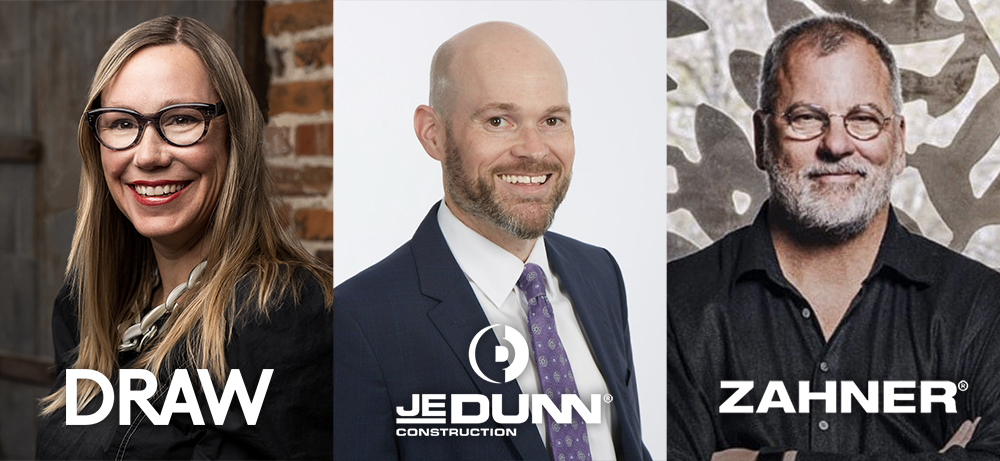The relationship between A/E/C firms and climate change is a pressing issue for many industry leaders. With new technology and collaboration, many firms are working to curb climate damage, committing to environmental protection and sustainability.
Leaders of several KC Global Design member firms, including DRAW Architecture, JE Dunn Construction and Zahner, are focused on reducing the industry’s environmental impact at both a local and global level.
Dominique Davison | DRAW Architecture
In a recent blog post, “The Kansas City, MO Climate Action plan, and what it means for architecture and planning,” Dominique Davison, founding principal of DRAW Architecture, explains that in order to reach Kansas City’s goal of reducing emissions from electricity use by 100% by 2030, firms need to be posing solutions to reduce buildings’ environmental impacts.
She writes, “The press has widely reported that buildings are responsible for 40% of GHG. According to the climate protection plan’s data, residential and commercial uses account for nearly 60% of GHGs in our region. We have a lot of work to do as residents of this community to reduce our carbon impact.”
Dominique illustrates how designers can work to create both cost-saving and environmentally-beneficial solutions for clients, sharing about what DRAW has been able to accomplish.
“Architects and engineers can show owners creative solutions to reduce their buildings’ environmental and GHG impacts. At DRAW, we do it for every project we design, including adaptive reuse or historic preservation of existing buildings. It isn’t difficult and it doesn’t have to be expensive if the long and short-term costs are considered,” she says.
The firm recently completed a plan for a small-scale project that reduced energy bills by $12,000 per year, along with a much larger commercial building that yielded savings of $500,000 over 10 years. In both cases, carbon impacts were reduced by roughly 30% while also saving the owners money.
Chris Migneron | JE Dunn Construction
At a 2022 KC Global Design Innovation Session, Chris Migneron, senior vice president of JE Dunn Construction, discussed the daunting reality of the building and construction industry’s impact on climate change, noting that it contributes to 37% of global CO2 emissions, with concrete and cement being among the biggest perpetrators.
To put these implications into perspective, Chris explained that the volume of building on Earth will double in the next 40 years. By 2060, the growth rate of the world population and the construction environment will be adding the equivalent of New York City in new construction every thirty days. As local, state and federal governments have begun to set benchmarks to reduce climate emissions, Chris noted that private clients and organizations are beginning to do the same.
He described some of the groundbreaking work JE Dunn and its partners are doing to be climate positive and equity affirming, stating that collaborative solutions to these difficult challenges and coming together to drive change are the first steps to making a difference.
A few collaboration highlights included exploring the utilization of materials that have a lower carbon footprint. In conjunction with NEXII Building Solutions, JE Dunn is exploring utilizing their proprietary, prefabricated reduced-embodied-carbon wall panels, which offer 20-35% lower carbon emissions over typical Portland Concrete.
Another notable collaboration involved ICON, a construction technology partner who is focused on the 3D printing of buildings, robotics and the development of alternate construction materials. The Austin, Texas-based company is working to solve the housing crisis through the 3D printing of environmentally-friendly homes for homeless individuals.
Chris concluded by noting the importance of thinking differently in the face of new challenges and the critical role the design community plays in shifting the approach toward climate change and its effects.
Bill Zahner | Zahner
In his recent article, “Life Cycle Assessment: Evaluating the Environmental Impact of Architectural Metals,” Bill Zahner, CEO/President at Zahner, explains why metal is one of the most durable and sustainable construction materials.
“The Life Cycle Assessment (LCA) standard is one method of examining the environmental effects of a material or product over its life cycle. It supports better material selection and design decisions,” he says.
Metals specific to Zahner projects, such as aluminum, copper, zinc and iron, are examined as an aggregate group under the Life Cycle Analysis, from their initial extraction, through manufacture and use, and on to the end of their designed useful life.
The article emphasizes metal’s durability, explaining that it can stand the test of weather and human interaction, lasting for generations.
In its final stage of life – re-use, recycle, disposal – metal offers a unique advantage. “Metals – and only metals – can be used indefinitely as building materials,” says Bill.
Bill closes by noting, “One can conclude that architectural metals offer a sustainable edge when it comes to designing and building with the environment in mind.”

